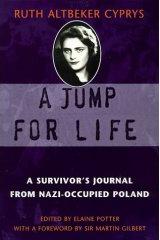
Welcome to the ezine produced by SGI Buddhists that prompts the positive, kindles the constructive, highlights the hopeful and leaves you feeling - well, up!


Review by Alex Canfor-Dumas
The Warsaw Ghetto was a place of unbelievable suffering. Established in Poland’s capital during the German Occupation in the Second World War, it housed 440.000 people in an area of less than three square miles.
In November 1940 the ghetto was sealed off from the outside world. Those who weren’t carted off to slave and extermination camps died of starvation and disease. In 1943 the heroic Warsaw Ghetto Uprising took place. It was the first urban mass rebellion against the Nazi occupation of Europe.Ruth Altbeker Cyprys was a young Jewish lawyer in Warsaw when the Germans invaded Poland. Most of Ruth’s family fled as the Nazi tanks rolled into the capital and her husband, George, was drafted into the Polish army. But Ruth, pregnant with her first child, remained in Warsaw, largely because of a promise to her brother.
Her account of her survival in Nazi-occupied Poland, written as a journal immediately after the war and hidden away until after her death, more than thirty years later, is a remarkable document of a survivor. Intelligent, spirited and very courageous, Ruth was determined to save herself and her little daughter Eva.
At the end of October 1940, a decree was published in Warsaw announcing
the formation of the Jewish quarter - the ghetto - where all Jewish
inhabitants were forced to liver under increasingly harrowing
conditions. From then until the end of the war, Ruth was to witness
the depths to which humanity could sink as well as the great heights to
which it could rise:
I realized then that good and evil were to be found side by
side in this world, or even striding together in equal measure
in one person.
Terror, starvation and random killings were commonplace in the ghetto,
but the summer of 1942 marked the beginning of the comprehensive and
systematic destruction of whole Jewish communities. Ruth details the
awful brutality of the selection process by the extermination squads,
which she survives on two occasions due to her courage and quick
thinking.
Procuring a thin hacksaw blade and a pair of boots in which to conceal it, she practices sawing through any metal objects she can find. Soon the day comes when the hacksaw is needed for real. The moment when she cuts through the bars of the cattle truck deporting her to Treblinka death camp, and jumps from the fast-moving train with her two-year-old daughter, is one of the most dramatic and heart-stopping moments in the journal.
Ruth encounters a remarkable set of people - all complete strangers - who inexplicably come to her aid and ensure her survival. Considering that the death penalty was waiting for anyone who helped a Jewish citizen, these people displayed great courage and humanity.
Travelling back to Warsaw but with no documents to hide her Jewish
identity, Ruth finally thinks her luck has run out when the police raid
her train to check on all the passengers. Clutching her daughter, she
waits for the inevitable, and is speechless when a lady in her
compartment hands her a piece of paper before getting out:
I fingered the certificate. How strange and miraculous! From now
on my name was to be Marianna Lukaszewska. Thus I got a Christian
name and Aryan parents. What an unbelievable and wonderful thing
to have happened. Under this new name I started my new life.
With her blonde hair, blue eyes and new identity, Ruth is now able to
blend into ‘Aryan’ Warsaw. The once glamorous advocate now dons drab
clothes and becomes a governess to a succession of young Polish
children.
Her ability to take incredible risks and make split-second decisions are the qualities that keep Ruth and her daughter alive. Each time she reaches a deadlock, something gives way to let her through, making the impossible possible. It seems as if the universe itself is responding to her incredible efforts to survive, so that she can chronicle the events she witnesses.
Ruth Altbeker Cyprys chose life when she jumped from the cattle truck transporting her to certain death in Treblinka. And in the face of pain, fear, persecution and challenges that, thankfully, few of us will ever have to face, she continued to fight for that life. Her journal is a testimony to courage. Read it and be inspired.

